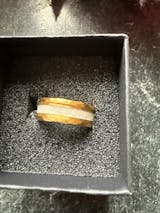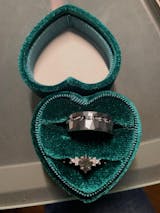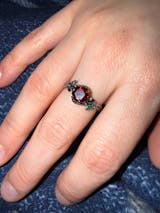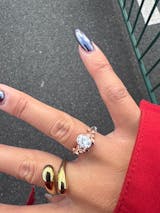Opal vs Moonstone

Opal vs Moonstone: The Complete Guide to Choosing Your Perfect Gemstone
Are you torn between the fiery dance of opal and the mystical glow of moonstone? You're not alone! These two stunning gemstones have captivated jewelry lovers for centuries, each offering unique beauty that can make choosing between them feel overwhelming.
This comprehensive guide will help you understand every aspect of these precious stones, from their scientific properties to their investment potential, so you can make the perfect choice for your needs.

Introduction: Understanding the Opal vs Moonstone Dilemma
Why This Comparison Matters for Jewelry Buyers
When you're shopping for a special piece of jewelry, the gemstone you choose becomes part of your story. Both opal and moonstone offer incredible beauty, but they serve different purposes and personalities. Understanding their differences helps you make a choice you'll love for years to come.
Common Misconceptions About These Gemstones
Many people think all opals are fragile or that moonstone is just "cloudy quartz." These myths can lead to poor buying decisions. The truth is both stones have unique characteristics that make them suitable for different types of jewelry and lifestyles.
Quick Comparison Table
|
Aspect |
Opal |
Moonstone |
|
Hardness |
5.5-6.5 (Mohs) |
6-6.5 (Mohs) |
|
Main Feature |
Play-of-color |
Adularescence |
|
Price Range |
$10-$20,000/carat |
$10-$1,000/carat |
|
Best For |
Statement jewelry |
Daily wear |
|
Durability |
Moderate |
Good |
|
Rarity |
Varies widely |
Common to rare |
Fundamental Differences: The Science Behind the Beauty
A. Chemical Composition and Formation
Opal: Nature's Rainbow Trapped in Stone
Opal is made of hydrated silica (SiO₂·nH₂O) - basically tiny spheres of silica packed together with water molecules. Think of it like nature's own bubble wrap, but instead of air, there's water between microscopic glass balls. This unique structure is what creates opal's famous rainbow colors.

Scientific diagram showing how opal's silica spheres create the play-of-color effect
Opals form when silica-rich water seeps into rock cracks and slowly evaporates over thousands of years. The process is so delicate that even small changes in temperature or pressure can affect the final stone's quality.
Moonstone: The Gentle Giant
Moonstone belongs to the feldspar family with the formula KAlSi₃O₈. It forms in a completely different way - through slow cooling of molten rock deep underground. As the rock cools, different minerals separate into layers, creating moonstone's signature glow.
B. Crystal Structure and Optical Phenomena
Opal's Play-of-Color: A Light Show in Stone
When light hits an opal, it gets trapped between those tiny silica spheres we mentioned earlier. The light bounces around and splits into different colors - just like a prism! The size of the spheres determines which colors you see:
- Small spheres = Blue and violet colors
- Medium spheres = Green and yellow colors
- Large spheres = Red and orange colors
Moonstone's Adularescence: The Moon's Own Magic 🌕

Scientific diagram showing moonstone's layered structure and how adularescence is created
Moonstone's glow comes from something called adularescence - a soft, billowy light that seems to float just beneath the surface. This happens because moonstone has microscopic layers of different feldspar minerals. When light enters the stone, it bounces between these layers, creating that dreamy, moon-like glow.
Physical Properties: Durability and Characteristics
A. Hardness and Durability Comparison

Mohs hardness scale showing where opal and moonstone rank in terms of durability
Both stones sit in a similar range on the Mohs hardness scale, but this doesn't tell the whole story.
Opal Durability (5.5-6.5 Mohs):
- Softer than quartz (which is 7)
- Can be scratched by everyday items like steel
- More prone to chipping and cracking
- Water content makes it sensitive to temperature changes
Moonstone Durability (6-6.5 Mohs):
- Slightly harder than most opals
- Better resistance to scratches
- Can still chip if hit hard
- More stable in different climates
What does this mean for you? Both stones need care, but moonstone is generally more forgiving for everyday wear.
B. Other Physical Properties
Density and Weight:
- Opal: 1.9-2.3 g/cm³ (lighter feeling)
- Moonstone: 2.5-2.6 g/cm³ (feels more substantial)
Temperature Sensitivity:
- Opal can crack from sudden temperature changes
- Moonstone is much more stable
Varieties and Classifications: The Complete Spectrum
A. Opal Classifications

Collection showcasing different opal varieties: white opal, black opal, fire opal, boulder opal, and Ethiopian opal
Precious Opal vs Common Opal:
- Precious opal shows play-of-color (the rainbow effect)
- Common opal has no color play but can be beautiful in solid colors
Main Types You'll Encounter:
1. White Opal - Light background with colorful flashes
2. Black Opal - Dark background that makes colors pop dramatically
3. Fire Opal - Orange to red body color, may or may not show play-of-color
4. Boulder Opal - Opal formed in ironstone, often with striking patterns
5. Ethiopian Opal - Often transparent with vivid colors
B. Moonstone Varieties

Collection of moonstone varieties: blue moonstone, rainbow moonstone, peach moonstone, gray moonstone, and white moonstone
True Moonstone Types:
1. Adularia Moonstone - The classic variety from Switzerland
2. Orthoclase Moonstone - Most common commercial variety
Special Varieties:
- Blue Moonstone - Shows blue adularescence (most valuable)
- Rainbow Moonstone - Actually labradorite! Shows multiple colors
- Peach Moonstone - Warm, peachy body color
- Gray Moonstone - Subtle and sophisticated
- Cat's Eye Moonstone - Shows a sharp line of light
- Star Moonstone - Displays a four-rayed star (very rare)
Origins and Geographic Sources: From Mine to Market
A. Primary Mining Locations

World map showing major opal and moonstone mining locations around the globe
Opal Mining Hotspots:
Australia (90% of world's opals):
- Lightning Ridge - Famous for black opals
- Coober Pedy - Underground mining town, white opals
- Andamooka - Matrix opals and painted stones
Ethiopia:
- Welo Province - Transparent opals with vivid colors
- Generally more affordable than Australian stones
- Can be less stable (some are hydrophane - they absorb water)
Mexico:
- Fire opals in orange and red colors
- Often transparent without play-of-color
Moonstone Sources:
Sri Lanka:
- World's finest blue moonstones
- Meetiyagoda - Historic mining region
- Produces the most valuable specimens
India:
- Large quantities of commercial moonstone
- Various colors including peach and gray
Myanmar (Burma):
- High-quality moonstones
- Often has excellent transparency
B. Supply Chain and Market Dynamics
The journey from mine to your jewelry box involves multiple steps, each affecting the final price:
1. Mining - Labor-intensive, especially for opals
2. Rough sorting - Identifying quality grades
3. Cutting - Skilled work that can make or break a stone
4. Wholesale markets - Where dealers buy inventory
5. Retail - Your final purchase point
Did you know? Ethiopian opals have disrupted the opal market since 2008, offering beautiful stones at lower prices than traditional Australian opals.
Color, Clarity, and Visual Appeal: Aesthetic Comparison
A. Color Analysis
Opal Color Grading:
The value of an opal depends heavily on its color display:
- Dominant colors: Red is most valuable, followed by orange, yellow, green, blue, indigo, violet
- Color saturation: Vivid colors worth more than pale ones
- Pattern: Uniform patterns often more valuable than random ones
- Directional vs. non-directional: Colors visible from all angles are premium
Moonstone Color Preferences:
- Blue adularescence on colorless base - most valuable
- Multi-colored rainbow effect - popular but technically not true moonstone
- Body color variations: Colorless, cream, peach, gray, green
B. Clarity and Inclusions
Acceptable Inclusions:
Opal:
- Some cloudiness acceptable in white opals
- "Potch" (common opal) layers can add character
- Sand inclusions common in boulder opals
Moonstone:
- Centipede inclusions - tiny tube-like structures (actually desirable in some cases)
- Needle-like inclusions - can create cat's eye effect
- Clean stones preferred but small inclusions acceptable
Value and Investment Potential: Market Analysis
A. Price Comparison and Factors
Current Market Prices (2024):
Opal Price Ranges:
- Commercial grade: $10-50 per carat
- Good quality: $50-500 per carat
- Fine quality: $500-5,000 per carat
- Investment grade: $5,000-20,000+ per carat
Moonstone Price Ranges:
- Commercial grade: $10-50 per carat
- Good quality: $50-200 per carat
- Fine blue moonstone: $200-1,000 per carat
- Exceptional specimens: $1,000+ per carat
Investment Potential Analysis:
Opals have shown stronger long-term appreciation, particularly:
- Australian black opals from established mines
- High-quality Ethiopian opals (though more volatile)
- Stones with exceptional color and pattern
Moonstones offer more stable, modest growth:
- Blue moonstones from Sri Lanka hold value well
- Growing popularity in designer jewelry
- More affordable entry point for collectors
B. Grading and Certification
Professional Grading Standards:
For opals, look for evaluation of:
- Brightness (1-5 scale)
- Color (spectral range and intensity)
- Pattern (uniform vs. irregular)
- Body tone (N1-N9 scale for black to white)
For moonstones, focus on:
- Adularescence quality (intensity and coverage)
- Body color and transparency
- Cut quality (proper dome shape crucial)
Certification Bodies:
- GIA (Gemological Institute of America) - most trusted
- AGTA (American Gem Trade Association)
- Gübelin - Swiss lab, premium reputation
- SSEF - Swiss Gemmological Institute
Jewelry Applications: Design and Setting Considerations
A. Optimal Jewelry Settings
Best Metals for Each Gemstone:
Opal Settings:
- Gold (yellow, white, or rose) - traditional and protective
- Sterling silver - affordable, complements lighter opals
- Platinum - premium protection for valuable stones
- Avoid: Overly rigid settings that might crack the stone
Moonstone Settings:
- Silver - classic pairing, enhances the mystical quality
- Gold - warmer tones complement peach moonstones
- Bezel settings - excellent protection for the stone
- Cabochon cuts - essential for proper adularescence display
B. Occasion and Lifestyle Matching
Daily Wear Recommendations:
- Moonstone: Better choice for rings and bracelets due to its superior durability. If you're considering everyday jewelry, you might want to buy moonstone rings that can withstand regular wear.
- Opal: Excellent for pendants and earrings, protected settings for rings. For special occasions, buy opal rings that showcase the stone's dramatic beauty while providing adequate protection.
Special Occasion Pieces:
- Opal: Dramatic statement pieces, cocktail rings
- Moonstone: Elegant, understated luxury
Beautiful moonstone engagement ring with vintage-inspired rose gold setting
Engagement Ring Considerations:
When it comes to engagement rings, both stones offer unique advantages. Those drawn to opal's spectacular color play can shop opal engagement rings designed with protective settings for this once-in-a-lifetime piece. Alternatively, couples seeking timeless elegance might prefer to shop moonstone engagement rings for their superior durability and classic appeal.
Care, Maintenance, and Longevity
A. Cleaning and Storage
Safe Cleaning Methods:
Opal Care :
- Use only lukewarm water and mild soap
- Soft brush (old toothbrush works)
- Never use: Ultrasonic cleaners, steam cleaners, harsh chemicals
- Storage: Slightly humid environment (dry air can cause cracking)
Moonstone Care :
- Warm soapy water is fine
- Can handle ultrasonic cleaning (though not recommended)
- Avoid: Harsh chemicals, extreme temperatures
- Storage: Normal jewelry storage is fine
B. Repair and Restoration
Common Damage Types:
- Opal: Crazing (tiny cracks), chipping, color loss
- Moonstone: Chipping, scratching, loss of polish
When to Seek Professional Help:
- Any visible cracks or chips
- Dull appearance that cleaning doesn't fix
- Loose settings
- Color changes in opal
Buying Guide: Making the Right Choice
A. Quality Assessment Criteria
Step-by-Step Evaluation Process:
1. Examine the stone in different lighting
- Natural daylight is best
- Avoid overly bright spotlights that hide flaws
2. Check for treatments
- Ask specifically about any enhancements
- Opal doublets/triplets should be disclosed
- Dyed or polymer-treated stones are less valuable
3. Evaluate the cut
- Opal: Look for even thickness, good polish
- Moonstone: Proper dome shape for best adularescence
4. Assess the setting
- Protective design appropriate for the stone
- Quality metalwork
- Secure prongs or bezels
B. Red Flags to Avoid ⚠️
- Prices that seem too good to be true
- Sellers who won't provide certification
- Stones with obvious flaws not disclosed
- High-pressure sales tactics
- "Investment grade" claims without documentation
Cultural and Metaphysical Significance
A. Historical and Cultural Context
Opal Through History:
- Ancient Romans believed opals brought good luck and contained the beauty of all gemstones
- Aboriginal Australians have dreamtime stories about opals being created by rainbows
- Medieval Europeans thought opals could make the wearer invisible
- Napoleon gave his wife Josephine a magnificent opal called "The Burning of Troy"
Moonstone's Journey:
- Ancient civilizations connected moonstone to lunar deities
- Hindu mythology claims moonstone is made of solidified moonbeams
- Art Nouveau jewelry featured moonstone extensively
- Modern crystal healing attributes emotional balance to moonstone
B. Modern Beliefs and Applications
Whether you believe in metaphysical properties or not, understanding these associations can help you choose a stone that resonates with your personal style and intentions:
Opal: Often associated with creativity, inspiration, and emotional expression
Moonstone: Connected to intuition, emotional balance, and new beginnings
Future Trends and Innovations
A. Technology in Gemstone Enhancement
Advanced Treatment Methods:
- Opal stabilization: Polymer treatments becoming more sophisticated
- Synthetic production: Lab-created opals improving in quality
- Enhancement detection: Better tools for identifying treatments
B. Market Predictions and Trends
Emerging Trends (2024-2025):
- Increased interest in ethically sourced gemstones
- Growing appreciation for Australian opal mining heritage
- Sustainable jewelry practices affecting sourcing
- Online buying becoming more sophisticated with better imaging technology
Investment Outlook:
- Australian black opals likely to appreciate due to limited supply
- Ethiopian opals may stabilize as market matures
- High-quality moonstones from traditional sources maintaining steady value
Conclusion: Your Personal Decision Framework
Choose Opal If You:
- Love dramatic, eye-catching jewelry
- Want a truly unique gemstone experience
- Are willing to invest in proper care and maintenance
- Appreciate the artistry and rarity of natural phenomena
- Have a higher budget for exceptional pieces
Choose Moonstone If You:
- Prefer subtle, elegant beauty
- Need jewelry suitable for daily wear
- Want better durability for your lifestyle
- Appreciate classic, timeless appeal
- Have a more moderate budget
The Ultimate Decision Matrix
Ask yourself these key questions:
1. What's your lifestyle like? Active = moonstone, special occasions = opal
2. What's your budget? Moonstone offers more options under $500
3. What's your style? Bold = opal, classic = moonstone
4. How much maintenance do you want? Low = moonstone, willing to pamper = opal
XIV. Final Recommendations
Both opal and moonstone offer incredible beauty and can be wonderful additions to your jewelry collection. The "right" choice depends entirely on your personal preferences, lifestyle, and budget.
For First-Time Buyers: Consider starting with a high-quality moonstone to experience the beauty of phenomenal gemstones with less risk.
For Collectors: Both stones offer exciting opportunities, with opals providing more dramatic potential returns and moonstones offering steady, reliable beauty.
For Daily Wear: Moonstone wins for durability and ease of care.
For Special Occasions: Opal's dramatic play-of-color makes it unbeatable for statement pieces.
Remember, the most important factor is choosing a stone that speaks to you personally. Whether you're drawn to opal's fiery dance or moonstone's gentle glow, either choice will bring you years of enjoyment when properly cared for.
Have questions about choosing between opal and moonstone? Feel free to ask - I'm here to help you make the perfect choice for your needs!











Lascia un commento